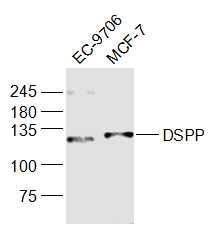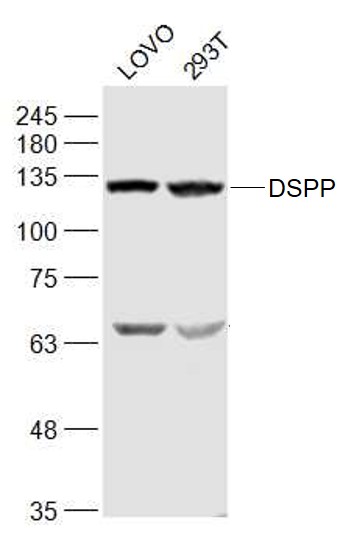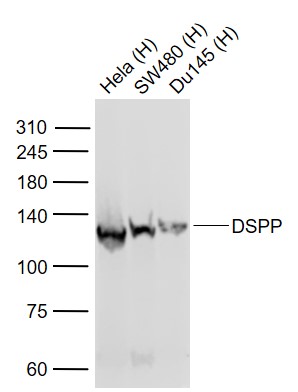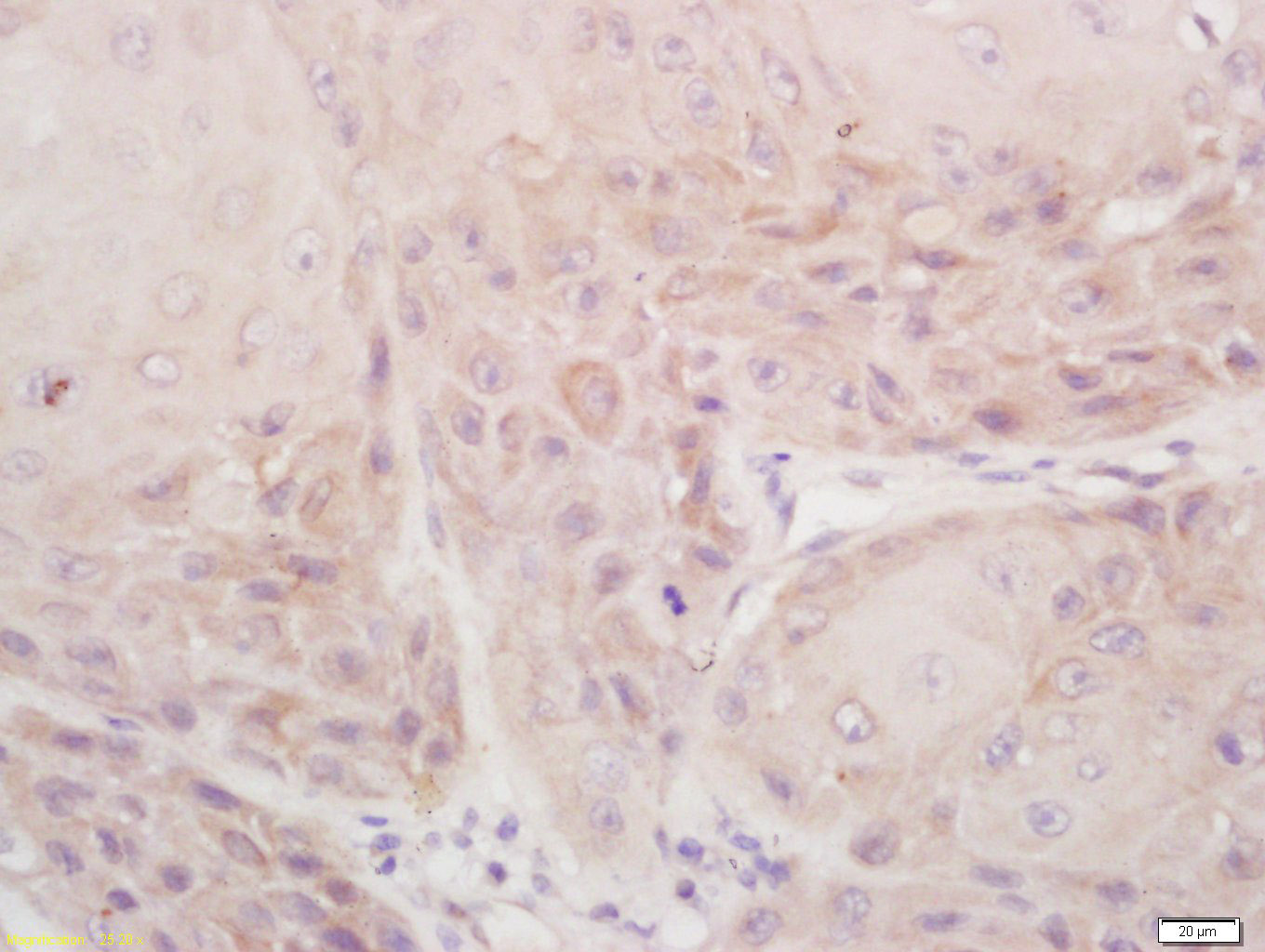
Rabbit Anti-DSPP antibody
Dentin phosphophoryn; Dentin phosphoprotein; dentin phosphoryn; Dentin sialophosphoprotein; Dentin sialophosphoprotein precursor; Dentin sialoprotein; dentinogenesis imperfecta 1; DFNA39; DGI1; DMP3; DPP; DSP; DSPP_HUMAN; DTDP2.
View History [Clear]
Details
Product Name DSPP Chinese Name 牙本质磷蛋白/牙本质骨唾液酸glycoprotein/牙本质骨唾液酸磷蛋白抗体 Alias Dentin phosphophoryn; Dentin phosphoprotein; dentin phosphoryn; Dentin sialophosphoprotein; Dentin sialophosphoprotein precursor; Dentin sialoprotein; dentinogenesis imperfecta 1; DFNA39; DGI1; DMP3; DPP; DSP; DSPP_HUMAN; DTDP2. literatures Research Area Cell biology immunology Signal transduction Cyclin Binding protein Cell differentiation Cytoskeleton Extracellular matrix Immunogen Species Rabbit Clonality Polyclonal React Species Human, Applications WB=1:500-2000 ELISA=1:5000-10000 IHC-P=1:100-500 IHC-F=1:100-500 IF=1:100-500 (Paraffin sections need antigen repair)
not yet tested in other applications.
optimal dilutions/concentrations should be determined by the end user.Theoretical molecular weight 47/129kDa Cellular localization Extracellular matrix Form Liquid Concentration 1mg/ml immunogen KLH conjugated synthetic peptide derived from human Dentin sialoprotein: 31-130/1301 Lsotype IgG Purification affinity purified by Protein A Buffer Solution 0.01M TBS(pH7.4) with 1% BSA, 0.03% Proclin300 and 50% Glycerol. Storage Shipped at 4℃. Store at -20 °C for one year. Avoid repeated freeze/thaw cycles. Attention This product as supplied is intended for research use only, not for use in human, therapeutic or diagnostic applications. PubMed PubMed Product Detail This gene encodes two principal proteins of the dentin extracellular matrix of the tooth. The preproprotein is secreted by odontoblasts and cleaved into dentin sialoprotein and dentin phosphoprotein. Dentin phosphoprotein is thought to be involved in the biomineralization process of dentin. Mutations in this gene have been associated with dentinogenesis imperfecta-1; in some individuals, dentinogenesis imperfecta occurs in combination with an autosomal dominant form of deafness. Allelic differences due to repeat polymorphisms have been found for this gene. [provided by RefSeq, Jul 2008]
Function:
DSP may be an important factor in dentinogenesis. DPP may bind high amount of calcium and facilitate initial mineralization of dentin matrix collagen as well as regulate the size and shape of the crystals.
Subunit:
Interacts with FBLN7.
Subcellular Location:
Secreted, extracellular space, extracellular matrix.
Tissue Specificity:
Expressed in teeth. DPP is synthesized by odontoblast and transiently expressed by pre-ameloblasts.
Post-translational modifications:
DSP is glycosylated.
DISEASE:
Defects in DSPP are the cause of deafness autosomal dominant type 39 with dentinogenesis imperfecta 1 (DFNA39/DGI1) [MIM:605594]. Affected individuals present DGI1 associated with early onset progressive sensorineural high-frequency hearing loss.
Defects in DSPP are the cause of dentinogenesis imperfecta type 1 (DGI1) [MIM:125490]; also known as dentinogenesis imperfecta Shields type 2 (DGI2). DGI1 is an autosomal dominant disorder in which both the primary and the permanent teeth are affected. It occurs with an incidence of 1:8000 live births. The teeth are amber and opalescent, the pulp chamber being obliterated by abnormal dentin. The enamel, although unaffected, tends to fracture, which makes dentin undergo rapid attrition, leading to shortening of the teeth.
Defects in DSPP are a cause of dentinogenesis imperfecta Shields type 3 (DGI3) [MIM:125500]. Patients with DGI3 do not have stigmata of osteogenesis imperfecta. The finding that a single defects in the DSPP gene causes both phenotypic patterns of DGI2 and DGI3 strongly supports the conclusion that these two disorders are not separate diseases but rather the phenotypic variation of a single genetic defect.
Defects in DSPP are the cause of dentin dysplasia type 2 (DTDP2) [MIM:125420]; also known as dentin dysplasia Shields type 2. DTDP2 is an autosomal dominant disorder in which mineralization of the dentine of the primary teeth is abnormal. On the basis of the phenotypic overlap between, and shared chromosomal location with DGI2 it has been proposed that DTDP2 and DGI2 are allelic. From the results of recent studies, it is clear that different types of mutations in DSPP lead to the two different phenotypes.
SWISS:
Q9NZW4
Gene ID:
1834
Database links:Entrez Gene: 1834 Human
Omim: 124585 Human
SwissProt: Q9NZW4 Human
Unigene: 678914 Human
Product Picture
EC-9706(Human) Cell Lysate at 30 ug
MCF-7(Human) Cell Lysate at 30 ug
Primary: Anti-DSPP (SL10316R) at 1/1000 dilution
Secondary: IRDye800CW Goat Anti-Rabbit IgG at 1/20000 dilution
Predicted band size: 47/129 kD
Observed band size: 129 kD
Sample:
LOVO(Human) Cell Lysate at 30 ug
293T(Human) Cell Lysate at 30 ug
Primary: Anti-DSPP (SL10316R) at 1/1000 dilution
Secondary: IRDye800CW Goat Anti-Rabbit IgG at 1/20000 dilution
Predicted band size:140 kD
Observed band size: 130 kD
Sample:
Lane 1: Hela (Human) Cell Lysate at 30 ug
Lane 2: SW480 (Human) Cell Lysate at 30 ug
Lane 3: Du145 (Human) Cell Lysate at 30 ug
Primary: Anti-DSPP (SL10316R) at 1/1000 dilution
Secondary: IRDye800CW Goat Anti-Rabbit IgG at 1/20000 dilution
Predicted band size: 140 kD
Observed band size: 130 kD
Tissue/cell: human laryngocarcinoma; 4% Paraformaldehyde-fixed and paraffin-embedded;
Antigen retrieval: citrate buffer ( 0.01M, pH 6.0 ), Boiling bathing for 15min; Block endogenous peroxidase by 3% Hydrogen peroxide for 30min; Blocking buffer (normal goat serum,C-0005) at 37℃ for 20 min;
Incubation: Anti-DSPP Polyclonal Antibody, Unconjugated(SL10316R) 1:200, overnight at 4°C, followed by conjugation to the secondary antibody(SP-0023) and DAB(C-0010) staining
Bought notes(bought amounts latest0)
No one bought this product
User Comment(Total0User Comment Num)
- No comment






 +86 571 56623320
+86 571 56623320
 +86 18668110335
+86 18668110335

